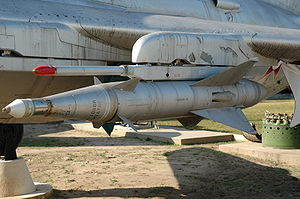K-5 (missile)
This article relies largely or entirely on a single source. (March 2013) |
| K-5 AA-1 Alkali | |
|---|---|
 K-5M | |
| Type | Short-range air-to-air missile |
| Place of origin | Soviet Union |
| Service history | |
| In service | 1957-1977 |
| Used by | Soviet Air Force |
| Production history | |
| Manufacturer | Kaliningrad Series Production Plant |
| Variants | K-55 |
| Specifications | |
| Mass | 82.7 kg (182 lb) |
| Length | 2.49 m (8 ft 2 in) |
| Diameter | 200 mm (7.9 in) |
| Warhead | High explosive |
| Warhead weight | 13 kg (29 lb) |
| Engine | Rocket |
Operational range | 2 to 6 kilometres (1.2 to 3.7 mi) |
| Maximum speed | 2,880 km/h (1,790 mph) (Mach 2.33) |
Guidance system | beam riding |
Launch platform | MiG-17, MiG-19, MiG-21, Su-9 |
The Kaliningrad K-5 (NATO reporting name AA-1 Alkali), also known as RS-1U or product ShM, was an early Soviet air-to-air missile.
History[edit]
The development of the K-5 began in 1951. The first test firings were in 1953. It was tested (but not operationally carried) by the Yakovlev Yak-25. The weapon entered service as the Grushin/Tomashevich (Russian: Грушин/Томашевич) RS-2U (also known as the R-5MS or K-5MS) in 1957. The initial version was matched to the RP-2U (Izumrud-2) radar used on the MiG-17PFU, MiG-19PM. An improved variant, K-5M or RS-2US in PVO service, entered production in 1959, matched to the RP-9/RP-9U (Sapfir) radar of the Sukhoi Su-9. The People's Republic of China developed a copy under the designation PL-1, for use by their J-6B fighters.
The difficulties associated with beam-riding guidance, particularly in a single-seat fighter aircraft, were substantial, making the 'Alkali' primarily a short-range anti-bomber missile. Around 1967 the K-5 was replaced by the K-55 (R-55 in service), which replaced the beam-riding seeker with the semi-active radar homing or infrared seekers of the K-13 (AA-2 'Atoll'). The weapon was 7.8 kg (17 lb) heavier than the K-5, but had a smaller 9.1 kg (20 lb) warhead. The K-55 remained in service through about 1977, probably being retired with the last of the Sukhoi Su-9 interceptors.
Specifications (RS-2US / K-5MS)[edit]
- Length: 2,500 mm (8 ft 2 in)
- Wingspan: 654 mm (2 ft 1.7 in)
- Diameter: 200 mm (7+7⁄8 in)
- Launch weight: 82.7 kg (182 lb)
- Speed: 800 m/s (2,880 km/h; 1,790 mph)
- Range: 2–6 km (1+1⁄4–3+3⁄4 mi)
- Guidance: beam riding
- Warhead: 13.0 kg (28.7 lb)
Operators[edit]

Current operator[edit]
 North Korea
North Korea- Used on MiG-21PFM.
Former operators[edit]
 Soviet Union
Soviet Union- Both the Soviet Air Force (VVS) and the Soviet Air Defence Forces (PVO) operated the K-5.
 China
China- The People's Liberation Army Air Force operated licensed Chinese copy of Kaliningrad K-5 designated as PL-1 (PL: short for Pi Li or Pili, meaning thunderbolt).
 Czechoslovakia
Czechoslovakia- The Czechoslovakian Air Force operated RS-2U and RS-2US.
 Hungary
Hungary- The Hungarian Air Force operated RS-2US on MiG-19PMs, MiG-21PFs and MiG-21MFs.
 Mali
Mali- Malian Air Force[1]
 Poland
Poland- The Polish Air Force operated RS-2US on MiG-17PMs, MiG-19PMs and MiG-21s, still in use as practice target.[2]
 Romania
Romania- Locally produced A-90 copy by Electromecanica Ploiesti (1984)
See also[edit]
References[edit]
- Citations
- ^ Cooper et al. 2011, p. 47
- ^ SRCP-WR z ITWL. pl.
- Bibliography
- Cooper, Tom; Weinert, Peter; Hinz, Fabian; Lepko, Mark (2011). African MiGs, Volume 2: Madagascar to Zimbabwe. Houston: Harpia Publishing. ISBN 978-0-9825539-8-5.
- Gordon, Yefim (2004). Soviet/Russian Aircraft Weapons Since World War Two. Hinckley, England: Midland Publishing. ISBN 1-85780-188-1.
External links[edit]
- RS-2U - Air-to-Air missile at aviation.ru
- K-5 at airwar.ru
- (in Russian)K-5 Archived 2020-08-24 at the Wayback Machine at missiles.ru
- - Electromecanica website: Air-to-Air missile
